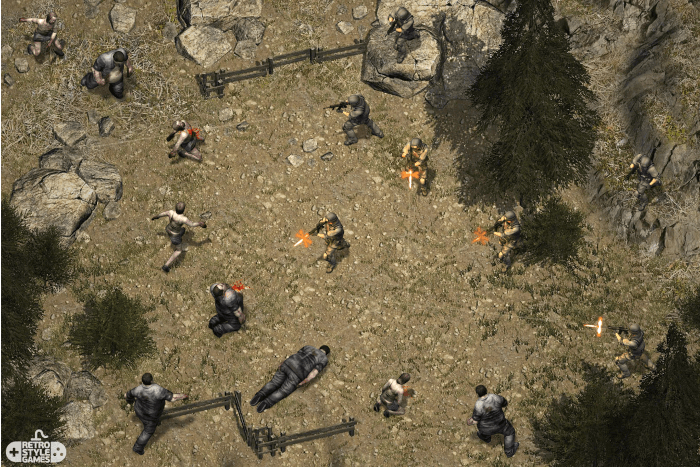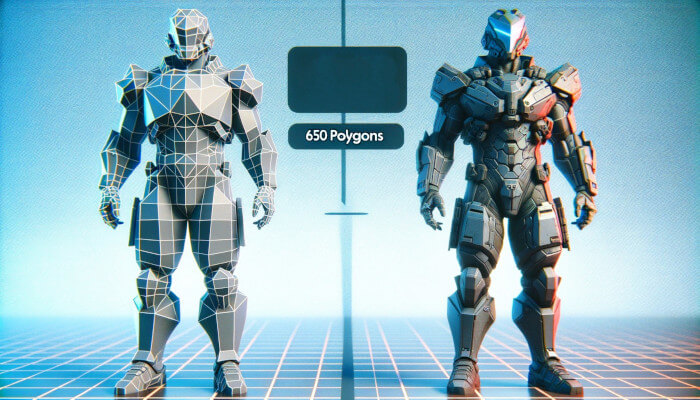In the exciting world of game development, seeing your ideas come to life is a thrilling experience. For those passionate about pixels and animations, it often starts with a key component: the sprite.
This guide introduces you to free 2D sprites for games, a rich resource for enhancing your digital projects. Whether you’re creating a thrilling adventure or a calm life simulation, the sprites you pick form the visual heart of your game.
Before we do that though, let’s be honest: if you try to find free sprites, chances are they’ll be shit. So sometimes it’s much better to use special services that custom design these 2D sprites, and it won’t be expensive as hell. Here’s an example
https://retrostylegames.com/outsourcing/3d-2d-game-sprites/
Yeap, game artists from RetroStyle Games also propose free sprites in their portfolio (on screenshot here’s an example of top-down soldier sprites).

Introduction to Free 2D Sprites
What is a Sprite?
A sprite is a 2D image or animation vital to a game’s visuals. It could be a character jumping through magical worlds or a tree in a pixel landscape. Sprites are more than just pretty; they’re the visual stories that engage players.
The Evolution of 2D Sprites in Gaming
Sprites were crucial in classic games, used for detailed animations and lively environments. They let developers tell stories pixel by pixel. Today, sprites remain key in game design, particularly for indie developers and hobbyists aiming to capture the feel of 2D classics.
![]()
The rise of digital tools has made game development more accessible. Free 2D sprites represent this openness and community spirit. They’re not just assets but invitations to blend art with technology, pushing game design boundaries. For both experienced developers and newcomers, free sprites provide a solid base for creativity, experimentation, and bringing your vision to life without budget or resource limits.
Why Choose Free 2D Sprites?
- Cost Savings: Indie developers often work with tight budgets. Free sprites help save money, allowing for creativity without worrying about costs.
- Wide Selection: There’s a huge, diverse collection of free 2D sprites available. You can find sprites for any type of game, whether you’re making a fantasy adventure or a sci-fi quest, in styles ranging from old-school to modern.
- Support from the Community: These sprites are often shared by a supportive community of developers and artists. This community understands the challenges of making games and shares their work to help others.
Differences Between Sprites and Polygons
Sprites are 2D images used for characters, objects, and backgrounds in games. They are easy to animate and preferred for their simplicity and retro charm by indie developers.
Polygons are used in 3D gaming. They’re shapes, like triangles, that make up 3D models. Unlike sprites, polygons need mathematical transformations for movement and animation, offering detailed and immersive visuals not possible with 2D sprites.
Choosing between sprites and polygons depends on your game’s style, the experience you want to offer, and your resources.

Sprite Drawing Methods
Buffering / Blitting
Buffering, often accompanied by blitting, is a classic method of sprite manipulation that remains relevant in game development today. Buffering refers to the process of storing image data in a temporary “buffer” before it’s rendered on the screen. This method allows for complex scenes to be composed and modified off-screen before being displayed to the player, reducing flicker and improving the overall smoothness of animations.
So, buffering stores image data temporarily before showing it on the screen, helping create smooth scenes. Blitting moves these images to the display, essential for rendering sprites efficiently and creating fluid animations.
Hardware Sprites
In early video games, hardware sprites were managed by the video hardware, not the game’s software.
This allowed smoother gameplay and complex scenes with minimal CPU impact. While less common today due to technological advances, understanding hardware sprites provides insights into game design history and graphic evolution.
![]()
Finding Free 2D Sprites
Luckily, the internet is filled with resources and communities aimed at helping game developers at every skill level.
Here are some prime sources for obtaining free sprites and tips for choosing the right ones for your game.
Top Sources for Free to Use Sprites
- OpenGameArt.org: A vast collection of game assets, including a wide range of free 2D sprites. Its community-driven approach encourages sharing between artists and developers.
- Itch.io: Though mainly an indie game platform, it also features a rich array of game assets like sprites. Assets here often come with flexible usage licenses.
- SpriteDatabase.net: A goldmine for fans of retro games, offering a vast collection of classic game sprites. Remember to consider copyright when using these for commercial projects.
- Kenney.nl: Provides hundreds of free asset packs, including 2D sprites, under a public domain license. Known for their quality and consistent style, making them ideal for a unified game look.
![]()
Selecting the Right Sprites
Choosing sprites involves more than preference; consider these factors:
- Art Style Consistency: All sprites should share a unified art style to avoid disrupting the game’s immersive experience.
- Functionality and Versatility: Ensure the sprites fit their intended use in your game, offering enough variation for different actions and expressions.
Implementing Free 2D Sprites
After choosing your sprites, the next challenge is integrating them into your game. This step transcends mere image importation; it’s about animation, interaction, and storytelling.
Integrating 2D Player Sprites
Player sprites are crucial, acting as the main interface for player interaction with the game world.
A variety of animations (walking, jumping, attacking) makes for engaging gameplay. At the same time, accurate collision detection ensures realistic interactions with the game environment.
Tips for Using Free Animated Sprites
While animated sprites add dynamism to your game, they can also impact performance. Optimize sprite animations to ensure they’re not consuming unnecessary resources.
Consistency is Key: Ensure that the style and frame rate of animations are consistent across all sprites to maintain a cohesive visual experience.
Benefits of Using Royalty-Free Sprites
Using royalty-free sprites in game development is not only about saving money; it’s a smart move with many benefits. Let’s look at the key advantages:
Cost-Effectiveness and Accessibility
For indie developers and hobbyists, the budget can often be a constraint that influences every aspect of game development.
By utilizing free assets, developers can significantly lower the expenses associated with game art creation, allowing for the allocation of resources to other critical areas such as game design, marketing, or further development.
There’s a wealth of high-quality, free sprites available online. This accessibility opens up game development to a broader audience, breaking down the barriers for aspiring creators who may not have the skills or resources to produce custom graphics.
Encouraging Creativity and Customization
While some might worry that using pre-made sprites could stifle creativity, the opposite is often true.
Looking through sprite collections can spark new ideas for games.
Many free sprites can be modified, allowing developers to customize them and create unique game designs.
Isometric Sprites: The Next Step in Game Design
As you get more comfortable with game development, you might want to add more depth and complexity to your games. This is where isometric sprites come in. They offer a 3D look in a 2D space, bridging the gap between simple 2D graphics and full 3D environments.
They add detail and a 3D feel to games without needing 3D models. The isometric view can lead to new game mechanics, like more complicated puzzles or navigation challenges.
Wrapping Up
Starting game development with free 2D sprites opens up a world of creativity and innovation. Whether you’re using classic pixel art or animated characters, free sprites are essential for bringing your vision to life. Royalty-free assets make game development more accessible and encourage customization and creativity.
Moving to isometric sprites is a key step in enhancing your game’s visual and gameplay depth. This challenge can transform your game, offering a unique perspective that attracts players.
In summary, no matter if you’re new to game development or looking to improve your current project, the resources and methods discussed provide a solid foundation for success. Remember, the heart of game development lies in the stories you tell and the experiences you create. So dive into the world of free 2D sprites and let your creativity flourish in your next game project.
FAQ
Where can I find high-quality free 2D sprites?
High-quality free 2D sprites are available on platforms such as OpenGameArt.org, Itch.io, and Kenney.nl. These websites offer a wide range of sprites for various game development needs.
Can I use free sprites in commercial projects?
Many free sprites come with licenses that allow for commercial use, but it’s crucial to review the specific terms of each asset. Look for assets under licenses like Creative Commons or those explicitly marked for commercial use.
What software is best for customizing 2D sprites?
Software like Adobe Photoshop, GIMP, and Aseprite are popular choices among developers for sprite customization. They offer robust tools for editing and animating sprites.
How do I integrate sprites into my game engine?
Integration depends on the game engine you’re using. Most engines, like Unity and Unreal Engine, have straightforward processes for importing and using sprites. Consult the documentation for your chosen engine for specific instructions.
What are the legal considerations for using free sprites?
Legal considerations include adhering to the asset’s license, which may require attribution or restrict commercial use. Always ensure you have the right to use an asset in your project to avoid copyright infringement.
Is it worth transitioning to isometric sprites for my game?
Transitioning to isometric sprites can provide a unique aesthetic and gameplay experience, making it worth considering for certain game genres. Evaluate whether the isometric perspective aligns with your game’s vision and goals.